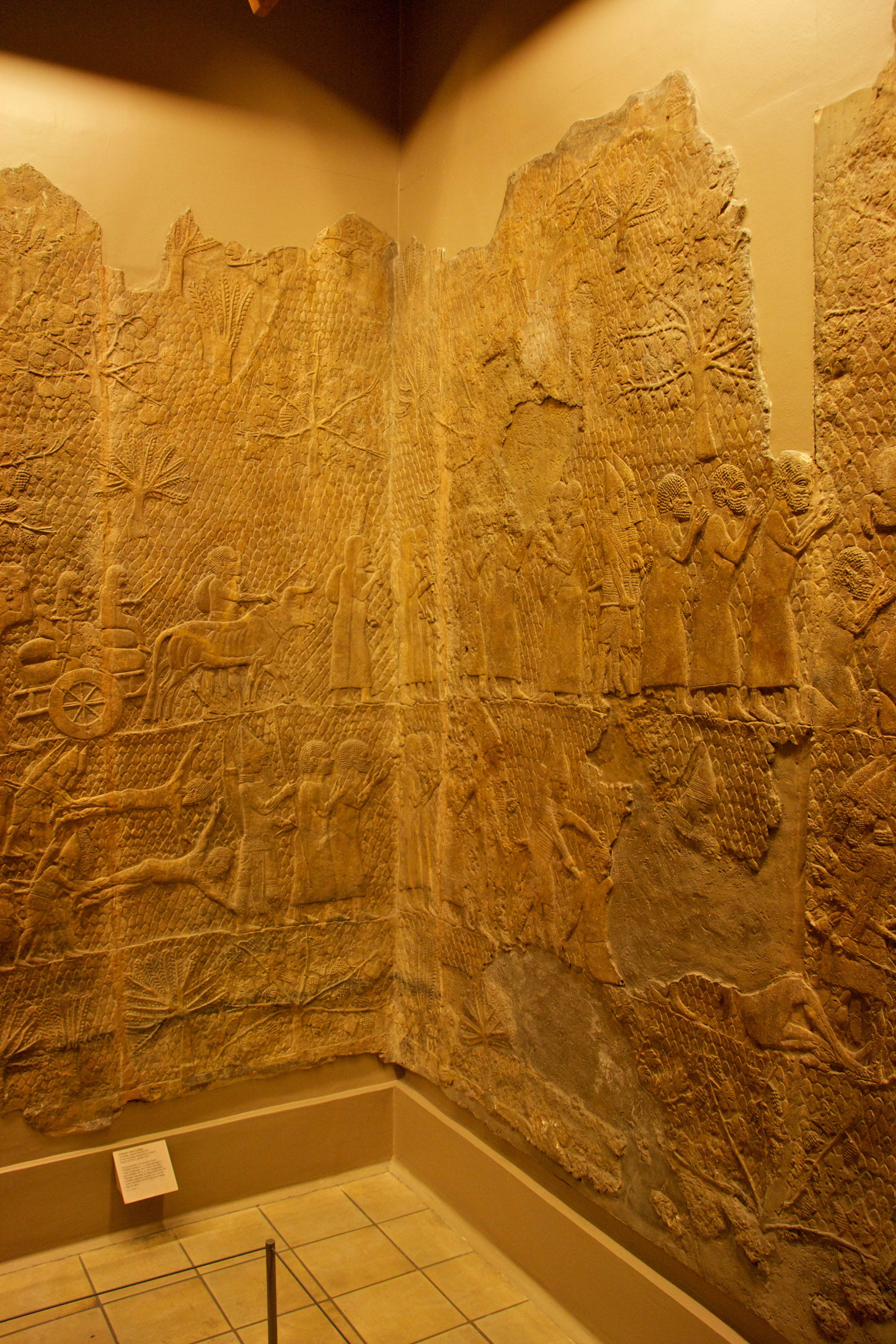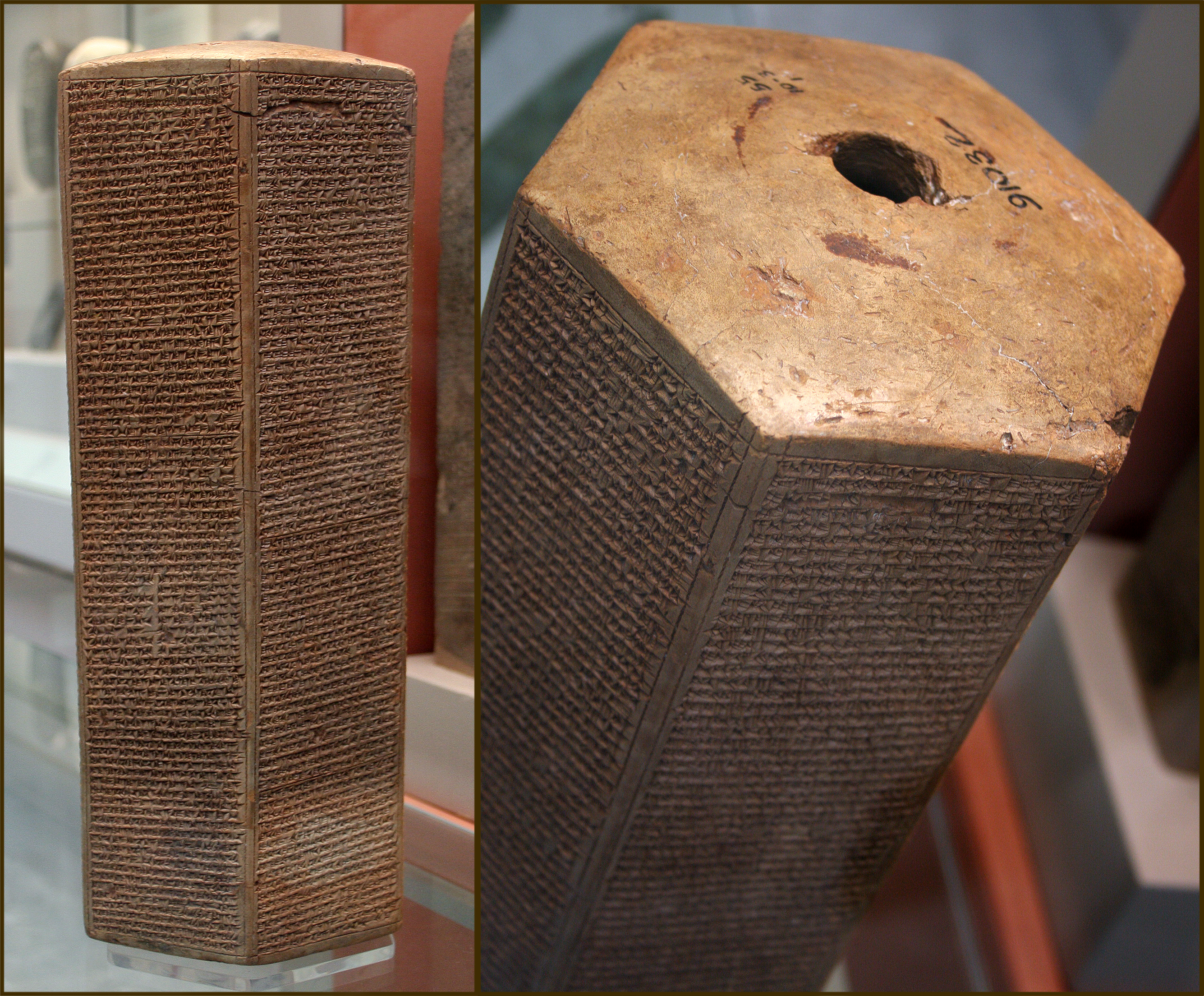|
Isaiah 37
Isaiah 37 is the thirty-seventh chapter of the Book of Isaiah in the Hebrew Bible or the Old Testament of the Christian Bible. This book contains the prophecies attributed to the prophet Isaiah, and is a part of the Book of the Prophets. Text The original text was written in Hebrew language. This chapter is divided into 38 verses. Textual witnesses Some early manuscripts containing the text of this chapter in Hebrew are of the Masoretic Text tradition, which includes the Codex Cairensis (895), the Petersburg Codex of the Prophets (916), Aleppo Codex (10th century), Codex Leningradensis (1008). Fragments containing parts of this chapter were found among the Dead Sea Scrolls (3rd century BC or later): * 1QIsaa: complete * 1QIsab: extant verses 7‑13 * 4QIsab (4Q56): extant verses 29‑32 There is also a translation into Koine Greek known as the Septuagint, made in the last few centuries BCE. Extant ancient manuscripts of the Septuagint version include Codex Vaticanus (B; ... [...More Info...] [...Related Items...] OR: [Wikipedia] [Google] [Baidu] |
Book Of Isaiah
The Book of Isaiah ( he, ספר ישעיהו, ) is the first of the Latter Prophets in the Hebrew Bible and the first of the Major Prophets in the Christian Old Testament. It is identified by a superscription as the words of the 8th-century BCE prophet Isaiah ben Amoz, but there is extensive evidence that much of it was composed during the Babylonian captivity and later. Johann Christoph Döderlein suggested in 1775 that the book contained the works of two prophets separated by more than a century, and Bernhard Duhm originated the view, held as a consensus through most of the 20th century, that the book comprises three separate collections of oracles: Proto-Isaiah ( chapters 1– 39), containing the words of the 8th-century BCE prophet Isaiah; Deutero-Isaiah ( chapters 40– 55), the work of an anonymous 6th-century BCE author writing during the Exile; and Trito-Isaiah ( chapters 56– 66), composed after the return from Exile. Isaiah 1– 33 promises judgment and restoration f ... [...More Info...] [...Related Items...] OR: [Wikipedia] [Google] [Baidu] |
Dead Sea Scrolls
The Dead Sea Scrolls (also the Qumran Caves Scrolls) are ancient Jewish and Hebrew religious manuscripts discovered between 1946 and 1956 at the Qumran Caves in what was then Mandatory Palestine, near Ein Feshkha in the West Bank, on the northern shore of the Dead Sea. Dating from the 3rd century BCE to the 1st century CE, the Dead Sea Scrolls are considered to be a keystone in the history of archaeology with great historical, religious, and linguistic significance because they include the oldest surviving manuscripts of entire books later included in the biblical canons, along with deuterocanonical and extra-biblical manuscripts which preserve evidence of the diversity of religious thought in late Second Temple Judaism. At the same time they cast new light on the emergence of Christianity and of Rabbinic Judaism. Most of the scrolls are held by Israel in the Shrine of the Book at the Israel Museum, but their ownership is disputed by Jordan due to the Qumran Caves' history: f ... [...More Info...] [...Related Items...] OR: [Wikipedia] [Google] [Baidu] |
Good News Translation
Good News Bible (GNB), also called the Good News Translation (GNT) in the United States, is an English translation of the Bible by the American Bible Society. It was first published as the New Testament under the name ''Good News for Modern Man'' in 1966. It was anglicised into British English by the British and Foreign Bible Society with the use of metric measurements for the Commonwealth market. It was formerly known as Today's English Version (TEV), but in 2001 was renamed the ''Good News Translation'' in the U.S., because the American Bible Society wished to improve the GNB's image as a translation where it had a public perception as a paraphrase. Despite the official terminology, it is still often referred to as the ''Good News Bible'' in the United States. It is a multi-denominational translation, with editions used by many Christian denominations. It is published by HarperCollins, a subsidiary of News Corp. Beginnings The beginnings of the Good News Bible can be traced to r ... [...More Info...] [...Related Items...] OR: [Wikipedia] [Google] [Baidu] |
Sennacherib's Annals
Sennacherib's Annals are the annals of the Assyrian king Sennacherib. They are found inscribed on a number of artifacts, and the final versions were found in three clay prisms inscribed with the same text: the Taylor Prism is in the British Museum, the Oriental Institute Prism in the Oriental Institute of Chicago, and the Jerusalem Prism is in the Israel Museum in Jerusalem. The Taylor Prism is one of the earliest cuneiform artifacts analysed in modern Assyriology, having been found a few years before the modern deciphering of cuneiform. The annals themselves are notable for describing Sennacherib's siege of Jerusalem during the reign of king Hezekiah. This event is recorded in several books contained in the Bible including Isaiah chapters 36 and 37; 2 Kings ; 2 Chronicles . The invasion is mentioned by Herodotus, who does not refer to Judea and says the invasion ended at Pelusium on the edge of the Nile Delta. Description and discovery The prisms contain six paragraphs of cune ... [...More Info...] [...Related Items...] OR: [Wikipedia] [Google] [Baidu] |
Isaiah 39
Isaiah 39 is the thirty-ninth Chapters and verses of the Bible, chapter of the Book of Isaiah in the Hebrew Bible or the Old Testament of the Christianity, Christian Bible. This book contains the prophecies attributed to the prophet Isaiah, and is a part of the Nevi'im, Book of the Prophets. This chapter concludes the section of Isaiah attributed to Isaiah himself (Proto-Isaiah). In the New King James Version, this chapter is sub-titled "The Babylonian Envoys". Isaiah foretells the Babylonian captivity, exile to Babylon of the people of Kingdom of Judah, Judah. Text The original text was written in Biblical Hebrew, Hebrew language. Chapters and verses of the Bible, This chapter is divided into 8 verses. Textual witnesses Some early manuscripts containing the text of this chapter in Biblical Hebrew, Hebrew are of the Masoretic Text tradition, which includes the Codex Cairensis (895), Codex Babylonicus Petropolitanus, the Petersburg Codex of the Prophets (916), Aleppo Codex (10th ... [...More Info...] [...Related Items...] OR: [Wikipedia] [Google] [Baidu] |
Isaiah 36
Isaiah 36 is the thirty-sixth chapter of the Book of Isaiah in the Hebrew Bible or the Old Testament of the Christian Bible. This book contains the prophecies attributed to the prophet Isaiah, and is a part of the Book of the Prophets. The text, describing the invasion of the Assyrian king Sennacherib to the Kingdom of Judah under Hezekiah. Text The original text was written in Hebrew language. This chapter is divided into 22 verses. Textual witnesses Some early manuscripts containing the text of this chapter in Hebrew are of the Masoretic Text tradition, which includes the Codex Cairensis (895), the Petersburg Codex of the Prophets (916), Aleppo Codex (10th century), Codex Leningradensis (1008). Fragments containing parts of this chapter were found among the Dead Sea Scrolls (3rd century BC or later): * 1QIsaa: complete * 4QIsab (4Q56): extant: verses 1-2 There is also a translation into Koine Greek known as the Septuagint, made in the last few centuries BCE. Extant a ... [...More Info...] [...Related Items...] OR: [Wikipedia] [Google] [Baidu] |
Parashah
The term ''parashah'' ( he, פָּרָשָׁה ''Pārāšâ'', "portion", Tiberian , Sephardi , plural: ''parashot'' or ''parashiyot'', also called ''parsha'') formally means a section of a biblical book in the Masoretic Text of the Tanakh (Hebrew Bible). In common usage today the word often refers to the Weekly Torah portion (a shortened form of ''Parashat HaShavua''). This article deals with the first, formal meaning of the word. In the Masoretic Text, ''parashah'' sections are designated by various types of spacing between them, as found in Torah scrolls, scrolls of the books of Nevi'im or Ketuvim (especially the Megillot), masoretic codices from the Middle Ages and printed editions of the masoretic text. The division of the text into ''parashot'' for the biblical books is independent of chapter and verse numbers, which are not part of the masoretic tradition. ''Parashot'' are not numbered, but some have special names. The division of ''parashot'' found in the modern-day To ... [...More Info...] [...Related Items...] OR: [Wikipedia] [Google] [Baidu] |
Codex Marchalianus
Codex Marchalianus designated by siglum Q is a 6th-century Greek manuscript copy of the Greek version of the Hebrew Bible (Tanakh or Old Testament) known as the Septuagint. The text was written on vellum in uncial letters. Palaeographically it has been assigned to the 6th century. Marginal annotations were later added to the copy of the Scripture text, the early ones being of importance for a study of the history of the Septuagint. Its name was derived from a former owner, René Marchal. Description The manuscript is an in quarto volume, arranged in quires of five sheets or ten leaves each, like Codex Vaticanus or Codex Rossanensis. It contains text of the Twelve Prophets, Book of Isaiah, Book of Jeremiah with Baruch, Lamentations, Epistle of Jeremiah, Book of Ezekiel, Book of Daniel, with Susanna and Bel. The order of the 12 Prophets is unusual: Hosea, Amos, Micah, Joel, Obadiah, Jonah, Nahum, Habakkuk, Zephaniah, Haggai, Zechariah, and Malachi. The order of books is the ... [...More Info...] [...Related Items...] OR: [Wikipedia] [Google] [Baidu] |
Codex Alexandrinus
The Codex Alexandrinus (London, British Library, Royal MS 1. D. V-VIII), designated by the siglum A or 02 (in the Gregory-Aland numbering of New Testament manuscripts), δ 4 (in the von Soden numbering of New Testament manuscripts), is a manuscript of the Greek Bible,The Greek Bible in this context refers to the Bible used by Greek-speaking Christians who lived in Egypt and elsewhere during the early history of Christianity. This Bible contained both the Old and New Testaments in Koine Greek. written on parchment. Using the study of comparative writing styles (palaeography), it has been dated to the fifth century. It contains the majority of the Greek Old Testament and the Greek New Testament. It is one of the four Great uncial codices (these being manuscripts which originally contained the whole of both the Old and New Testaments). Along with Codex Sinaiticus and Vaticanus, it is one of the earliest and most complete manuscripts of the Bible. It derives its name from the ... [...More Info...] [...Related Items...] OR: [Wikipedia] [Google] [Baidu] |
Biblia Hebraica (Kittel)
''Biblia Hebraica'' refers primarily to the three editions of the Hebrew Bible edited by Rudolf Kittel. When referenced, Kittel's ''Biblia Hebraica'' is usually abbreviated BH, or BHK (K for Kittel). When specific editions are referred to, BH1, BH2 and BH3 are used. ''Biblia Hebraica'' is a Latin phrase meaning Hebrew Bible, traditionally used as a title for printed editions of the Tanakh. Less commonly, ''Biblia Hebraica'' may also refer to subsequent editions in the ''Biblia Hebraica'' series which build on the work of Kittel's editions. Editions by Kittel The Old Testament scholar Rudolf Kittel from Leipzig started to develop a critical edition of the Hebrew Bible in 1901, which would later become the first of its kind. His first edition ''Biblia Hebraica edidit Rudolf Kittel'' was published as a two-volume work in 1906 under the publisher J. C. Hinrichs in Leipzig. The second edition of Kittel's ''Biblia Hebraica'' appeared in 1913. BH3 appeared in installments, from 1929 t ... [...More Info...] [...Related Items...] OR: [Wikipedia] [Google] [Baidu] |
Codex Sinaiticus
The Codex Sinaiticus (Shelfmark: London, British Library, Add MS 43725), designated by siglum [Aleph] or 01 (in the Gregory-Aland numbering of New Testament manuscripts), δ 2 (in the von Soden numbering of New Testament manuscripts), or Sinai Bible is a 4th-century Christian manuscript of a Greek Bible, containing the majority of the Greek Old Testament, including the Apocrypha, and the Greek New Testament, with both the Epistle of Barnabas and the Shepherd of Hermas included. It is written in uncial letters on parchment. It is one of the four great uncial codices (these being manuscripts which originally contained the whole of both the Old and New Testaments). Along with Codex Alexandrinus and Codex Vaticanus, it is one of the earliest and most complete manuscripts of the Bible, and contains the oldest complete copy of the New Testament. It is a historical treasure, and using the study of comparative writing styles (palaeography), it has been dated to the mid-4th cen ... [...More Info...] [...Related Items...] OR: [Wikipedia] [Google] [Baidu] |
Codex Vaticanus
The Codex Vaticanus ( The Vatican, Bibl. Vat., Vat. gr. 1209), designated by siglum B or 03 (in the Gregory-Aland numbering), δ 1 ( von Soden), is a fourth-century Christian manuscript of a Greek Bible, containing the majority of the Greek Old Testament and the majority of the Greek New Testament. It is one of the four great uncial codices. Along with Codex Alexandrinus and Codex Sinaiticus, it is one of the earliest and most complete manuscripts of the Bible. The codex has been dated palaeographically to the 4th century. The manuscript became known to Western scholars as a result of correspondence between Erasmus and the prefects of the Vatican Library. Portions of the codex were collated by several scholars, but numerous errors were made during this process. The codex's relationship to the Latin Vulgate was unclear and scholars were initially unaware of its value. This changed in the 19th century when transcriptions of the full codex were completed. It was at that point that ... [...More Info...] [...Related Items...] OR: [Wikipedia] [Google] [Baidu] |





.jpg)


